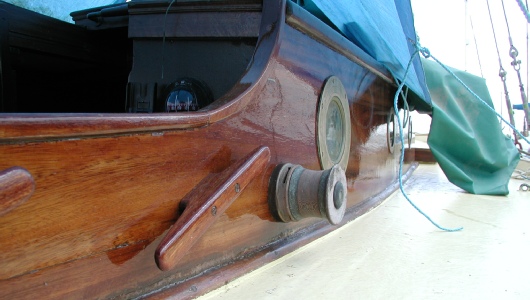


Partners: Rhys Warren-Thomas & Lawrence Weldon
Professional indemnity insurance arranged by Markel International




The scope of examination for the average sailing vessel will commonly included the following points
Hull:
- Glass fibre hulls are tested for high moisture content and osmosis. If necessary (and only in agreement with the vendor), an assessment is made of the water barrier coatings (gelcoat / epoxy) by removing antifouling paint in small tokens.
- The exterior planking on wooden hulls is sounded at close intervals throughout, including the stem, keel and transom. This inspection will also involve a check on the fairness (uniformity) of the hull lines which will highlight any failing of the internal support.
- Examination of the integral hull stiffening will include bulkheads and bonding, accommodation mouldings, moulded floors and stringers. On wooden vessels, the framing and the centreline structure, including longitudinals, is included.
- The condition of a ballast keel and fastenings is assessed, with consideration given to any available documented history of bolt renewals.
- An overall opinion as to the condition of the hull cosmetic exterior is expressed for maintenance and valuation reasons.
Deck:
- Deck structures are assessed for adequate support, including any mast support members. Timber-built deck structures are examined for failing joints and signs of leakage below.
- Decks of sandwiched core construction are tested for moisture ingress.
- Wooden deck coverings of either sheathed-over plywood or teak planking are examined visually and tested by sounding.
- Timber-built upperworks (cabin sides and coachroof surfaces) will undergo a close examination; this will invariably include soundings taken in order to determine areas of suspected timber decay.
- Hatches, portlights and windows are checked for soundness and function.
- Bulwarks, cappings, rubbing strakes and rails are checked for security.
- The overall condition of the cockpit structure is considered along with the adequacy of any drainage.
A check is made on the condition and security of the following items of deck gear:
- Rigging attachments and all associated supporting structures below deck.
- Anchors and mooring arrangements.
- Stanchions, guard-wires, grabrails and harness attachments.
- Winches and control line gear.
- Boarding ladder and davits.
Services to be checked will include:
- Steering gear and foils, shaft and bearings, control cabling of any accessible mechanisms.
- Electrical installations, including batteries and charging systems, wiring, panel switching and any installed shore power circuits.
- Skin fittings and transducers, including seacocks and connected plumbing.
- Fuel and water tanks, including delivery.
- WC and galley services.
- Installed heating systems.
- Bilge pumping.
- Cabin ventilation.
- Gas installations are examined and advised on accordingly.
The overall condition of the following areas of accommodation fit-out is included with pre-purchase reports:
- Joinery and glass fibre mouldings.
- Deckhead and hull linings.
- Handholds and rails.
- Soft furnishings.
An examination of the following rigging items is made, with recommendations duly considered in line with any available documented history of renewals:
- Mast and spars.
- Running rigging.
- Sails.
- Standing rigging.
- Furling gear.
Machinery:
- The structural security and safety of installed engine units including generators is assessed, including fuel and exhaust systems.
- The stern gear, bearings and inboard glands are checked for leakage and wear.
- The conductivity and wastage of any anodic protection is measured.
- An opinion is expressed on the adequacy of any ventilation and sound deadening offered through machinery compartments.
Equipment:
- Distress signalling, fire fighting and safety equipment is noted and advised on accordingly.
- Electronic navigational equipment and navigation lights are operated where appropriate.
- An inventory of equipment relating to safety and navigation, belonging to the vessel, is listed in a standard report.
- Where available, a power-up test is performed on electronics for pre-purchase reasons.
- General equipment including fenders, lines and covers is listed at the end of the report.